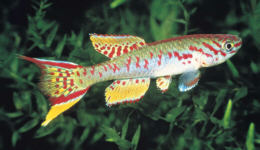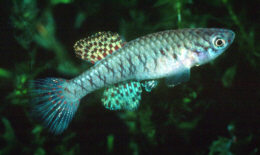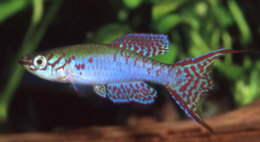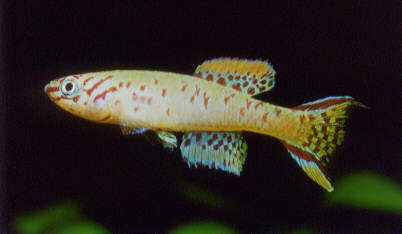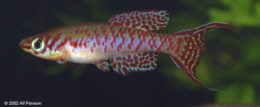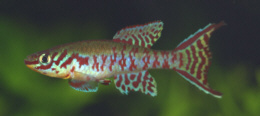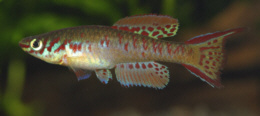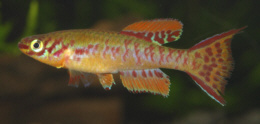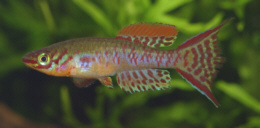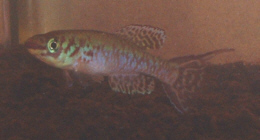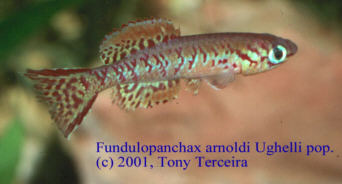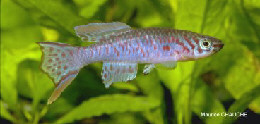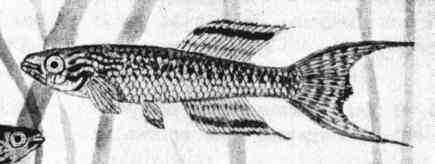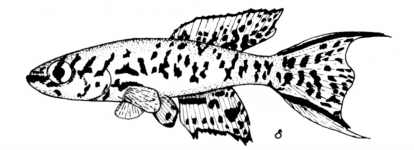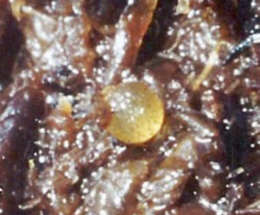Fundulopanchax arnoldi (Boulenger 1908)

Ughelli - NG MM 14
Photo courtesy of Tony Terceira
| Meaning of Name |
After Johann Paul Arnold, German aquarist. | ||||||||||||||||||||
| First Description |
Boulenger G.A. 1908. (Fundulus arnoldi). Description of two new Cyprinodont fishes from West Africa. Annals & Magazine of Natural History (8) 2 (7): p 29-30. Boulenger 1915 also gives other references-
| ||||||||||||||||||||
| Size |
5.5cm (in original description) | ||||||||||||||||||||
| Meristics |
| ||||||||||||||||||||
| Karyotype |
n = 19, A = 31 (Scheel 1990) | ||||||||||||||||||||
| Sub-Genus |
Paludopanchax | ||||||||||||||||||||
| Group |
| ||||||||||||||||||||
| Synonyms |
| ||||||||||||||||||||
Populations
CI 2011 CW - Commercial
import into the USA. |
BKA Import 1970's -
Calabar -
Ijebu -
Sapele -
TAAG 2003 / 3 -
Ughelli - Collected near Warri &
imported as a private shipment to Boston in the USA by Terceira &
Rossi in December 2001. Around 300 fish were imported in this shipment.
Tony commented to me how variable the males were & considered
Alf's photo's a true sample of the variability received.
Warri -
Wokocha River - Situated approximately 13 miles north of Port Harcourt on the road to Oweri.
Fp.arnoldi. Wild male (unknown location). Photo courtesy of Ed Pürzl. | ||||||||||||||||||||
| Type Locality |
The original description is given as 'mouths of the Niger' which is most likely the Niger delta. In Boulenger 1915 types 1-4 originate from Warri. Types 5 & 6, from Sapelle. All types being presented by Arnold. | ||||||||||||||||||||
| Distribution |
Mainly restricted to the Niger Delta & a little further to the northwest. | ||||||||||||||||||||
| Habitat |
Slow moving streams & swampy areas of small rivers & brooks in coastal rainforest.. | ||||||||||||||||||||
| Distinguishing Characteristics |
Similar to Fp.filamentosus but can be separated by the caudal peduncle which is much thinner. The caudal fin tends to fan out more in Fp.arnoldi. The general appearance of Fp.arnoldi is that of a more delicate fish. The unpaired fins of arnoldi are generally clear whereas these fins in filamentosum are spotted. Eggs seen under a microscope also show differences. Eggs of filamentosum are larger than arnoldi & have few 'hairs' whereas arnoldi are smaller & have a noticeable amount of 'hairs'. See also Fp.filamentosus. | ||||||||||||||||||||
| Colour/Pattern Variability | I
originally considered this to be low but then came the Ughelli TR 01
population which, as has been mentioned above, came in with a high degree
of variability. It would be interesting to hear from anyone breeding other populations to see if these also turned out to be variable in terms of colouration & patterning. |
||||||||||||||||||||
| History |
Originally collected by Groch, a German sailor from the Warri area in the western Niger Delta. Groch collected fish for Schroot of Hamburg. This shipment which arrived on the 5th of November 1905 contained 8 specimens of a new fish. Arnold bought one male & two females, the remainder were sold to Thumm who lost them all apparently. Arnold's stock also died in 1906 but 3 preserved specimens were sent to Boulenger who based his desciption on them. According to Scheel (Aquarium Journal May 1963), the first imports of this sp. contained 2 different colour forms, red & blue. The red form was introduced first & he considered this to be the 'typical' form. The blue form was identified by Boulenger as 'gardneri' & was pictured by Dietrich in 'Wochenschrift in 1915. This showed a filamentosum like form. Arnold is reported to have supplied these fish which were reportedly collected from Calabar (Cross River drainage). In 1906 another shipment containing 20 specimens arrived in Hamburg. Other shipments containing the species were also recorded in 1910 & 1911. After this their seems to be a gap until the next import in 1961. Other imports did arrive but these fish were considered to be Fp.filamentosum. Boulenger gives the following collectors / locations in his 1915 Catalogue.
In 1961 Ulf Hannerz collected Fp.arnoldi from the Wokocha River 12-13 miles from Port Harcourt in the direction of Oweri. These were returned to Stockholm but were difficult to keep alive & Hannerz gave Scheel the remaining stock. These were the first fish which were succesfully bred & raised in captivity. Scheel lost his stock in 1967.
This sp. was known to have been in the AKA 'some years' prior to 1963 as Franz Werneri from Detroit sent Scheel slides of a fish known as 'gardneri' which were now identifiable as filamentosum. East German aquarists had the species from Nigeria around this time & managed to breed them. These were apparently identical with the Wokocha River population. Imported by the BKA from the Sapele - Warri area to the west of the Niger Delta in December 1975. Also in this shipment were 2 pairs of Fp.deltaensis then called 'Deltafish' by John Parker. Around
1980 a pair was known to have been brought into the UK which | ||||||||||||||||||||
| Breeding Notes |
Not a very productive sp. Eggs are laid in productive periods with resting periods following where no attempts are made to spawn. Peat is a good substrate for egg laying although coconut fibre & silver sand should work equally well although I have not tried these on this sp. Semi-dry incubation takes about 6-10 weeks. Fry are small. Some literature states they will take newly hatched brine shrimp as a first food but I would prefer infusoria for a couple of days or a smaller shrimp such as San Francisco. Growth can be rapid with sexual maturity reported at 2 months. Water quality has been reported as important & should be soft & around 6.0 - 6.5 pH (rainwater is a good choice). Temperature 74-78'F. Velvet is a big killer of fry & tanks should be kept very clean especially of uneaten brine shrimp. The fry are salt tolerant & the addition of a teaspoon to the gallon is a wise precaution. J.P.Arnold wrote a breeding
account in the Aquarium Journal of June 1949. He used a 5 gallon tank for the
breeding pair planted with Vallisneria, added
one part of sea water to nine parts of fresh water. The temperature was 75°F,
no other measurements of pH etc were given in the article. The surface was covered
with large water ferns. He didn't use any aeration. The side of the tank nearest
a window was shaded with dark paper no higher than the water level (8").
The fish were fed a diet of mosquito larvae, chopped earthworms & Daphnia.
In this setup growth was rapid & the female became roed up. Otto
Böhm gave a breeding report in JAKA Vol.9 No.11, November 1976. He had a
pair from the UK. Eggs from this pair were examined at 8 weeks of dry incubation
& found to be fully developed. A further week was waited before putting the
eggs into water with the result that 12 fry emerged. These were fed on newly hatched
brine shrimp. They turned out to be 6 pairs. Otto recommended using 1 male to
2-3 females in a breeding setup. Sterba's 'Freshwater Fishes of the World p 488 considers them very prolific laying 15-25 eggs daily in a spawning period of 4-6 weeks. Eggs in water take 35-40 days of incubation. It is also stated that eggs from the 'blue race' are larger than those of the 'yellow race'. The AKA have been hatching the Ughelli population OK after 6 weeks of dry storage (from e-mail 7th Feb.2002). | ||||||||||||||||||||
| Diameter of Egg |
1·0 - 1·1 mm (Scheel).
| ||||||||||||||||||||
| Remarks |
Fry & adults are susceptible to velvet. Scheel considered them susceptible to mycobacteria infection & recommended maintaining them in 'clean, hard alkaline water'. In BKA auctions of 1988/89 they were fairly easy to find. It is thought that Fundulosoma thierryi is derived from this species. |

